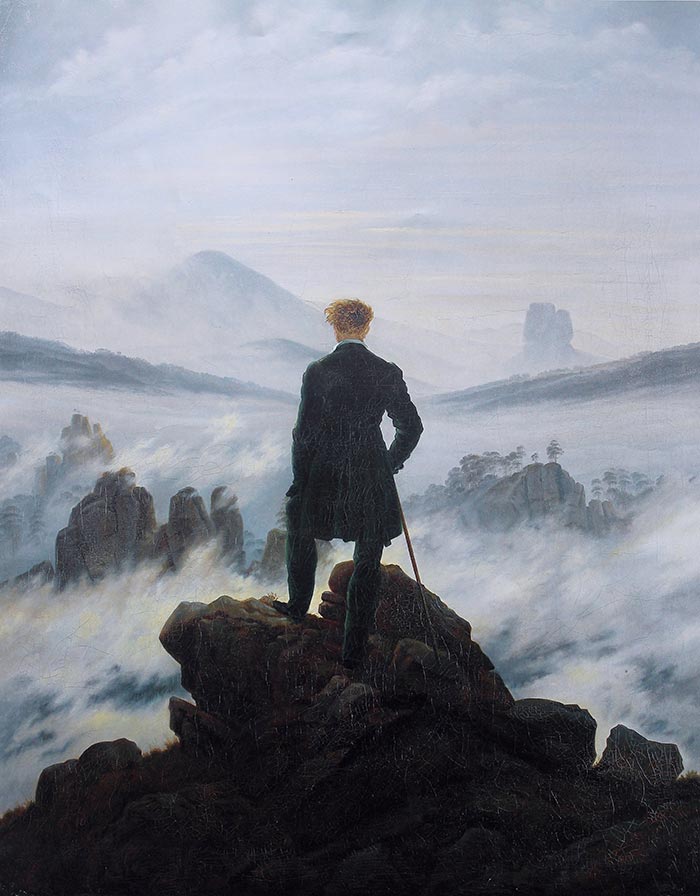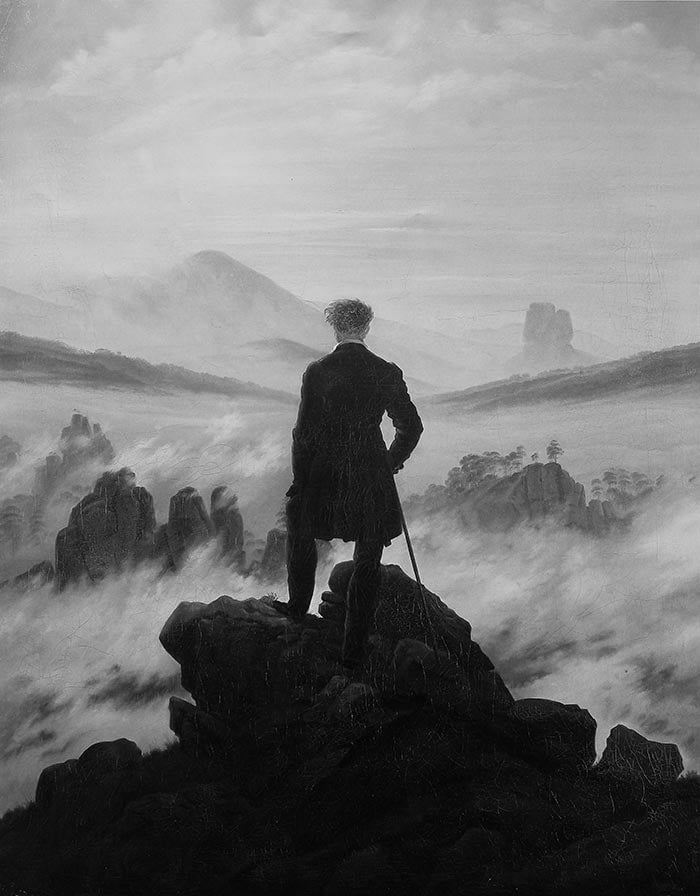Painting Fog Romanticism Art Wanderer Above the Sea of Fog
In this post, I accept a closer await at Wanderer Higher up the Sea of Fog by Caspar David Friedrich. It is an iconic piece of work of Romanticism that features a homo standing on the border of the rocky terrain, looking out over the foggy mural.

Caspar David Friedrich, Wanderer Above the Sea of Fog, 1818
Key Facts and Ideas
- It is also referred to every bitWanderer Above the Mist orMountaineer in a Misty Mural.
- The identity of the man is uncertain. Some accept suggested it is a self-portrait of the artist himself, pointing to similarities in appearance, such as the red hair. Historian Joseph Koerner provides a more than likely interpretation that it is a certain individual, Colonel Friedrich Gotthard von Brincken. In his book, Caspar David Friedrich and the Subject of Mural, he writes:
"Von Brincken was probably killed in action in 1813 or 1814, which would make the 1818 Wanderer Above the Sea of Fog a patriotic epitaph". Via Sothebys
- The landscape is based on the Elbe Sandstone Mountains in Saxony and Bohemia. It is not an exact depiction of the landscape, rather an amalgamation of various parts. Friedrich would travel the mountains and create sketches. Then, back in the studio, he would construct his own interpretation of the landscape.
- It is considered an iconic piece of work of Romanticism, which is characterized past a deep appreciation of nature.
Color and Light
The sun is the primary light source. The silhouette of the foreground suggests it is overhead and out in front.
The clouds and fog seem to be diffusing the calorie-free, meaning it is not a strong and direct light like the midday dominicus on a articulate day. This is considered to be a "good" light to paint under, equally it provides enough light for you to clearly see all the colors, but not then much equally to wash the colors out. (I provide a cheat sheet on how to paint under different types of lite in my Landscape Painting Starter Kit).
The colors are restrained, with mostly weak blues, pinks, and yellows. The painting relies much more than on value contrast (the dissimilarity betwixt light and dark elements) than hue or saturation dissimilarity. Refer to the grayscale image of the painting below.

As you lot tin see, there is a sharp contrast betwixt lite and dark elements. This is because near of the colors are at the extremes of the value scale (the colors are either really lite or actually dark; in that location are hardly whatsoever mid-tones).
Observe how the darks represent the human being, rocks, and other "solid" objects; whilst the lights represent the clouds, sky, and fog. So not only is there a contrast betwixt lite and dark, only also betwixt solid and transient.
The values in the painting also get gradually lighter as y'all recede into the distance, starting with the dark, imposing rocks in the foreground, and ending with the barely visible mountains in the background. The colors as well get a touch on cooler in temperature. This creates a sense of atmospheric perspective or depth.

Composition
Unlike most landscape paintings, Wanderer Above the Sea of Fog has portrait dimensions (taller than it is broad). This reiterates the upright stance of the man around the middle.
The stance of the man is an important feature of the painting in and of itself. He is leaning primarily on i leg and there is a slight shift in his trunk to counter this. This is known every bit contrapposto, which is Italian for "opposite" or "counter". It is considered a natural and visually pleasing opinion (think well-nigh what the painting would look like if he was standing direct and rigid).

Most of the painting is taken up by negative space (sky, clouds, and fog). Only, there is a sense of residue against the small but powerful areas of positive infinite (rocks, trees, and human).
Another interesting observation is the open aeroplane of the limerick. Other than the foreground at the lesser, there is no use of framing. This helps convey the vastness of the landscape.
Edges
In this painting, difficult edges are used for the rocks in the foreground and the man. This gives a sense of clarity and closeness. Much softer edges are used for the transient fog, clouds, and sky.
Notice how all the edges go softer as you lot recede into the altitude, yet the relationships stay intact. Past relationships, I hateful how hard one edge is compared to another.
For case, if you look at the foreground, the edges used for the rocks are harder than the edges used for the fog.
At present, look at the afar mountains. In full general, this area is much softer than the foreground. But, the relationships are the aforementioned—the edges of the mountains are harder than the fog, clouds, and heaven.
The fundamental point here is that relationships matter, much more than the absolute hardness of an edge.
I as well describe your attention to the different techniques Friedrich used to alter the hardness of the edges.
One technique is gently blending one color into the next. This softens the edge betwixt two color shapes. The more than the colors are composite, the softer the edge.
The other technique relies on the use of dissimilarity, in particular, color contrast. The idea is this: the sharper the contrast between ii shapes, the harder the edge. For instance, take the following two shapes:

The contrast is sharp and the edge is hard. Watch what happens if I reduce the color dissimilarity between the two shapes.

The transition between the ii colors is just as abrupt, merely the edge appears much softer.
Below are two more examples using colors from the painting. The first with colors from the foreground—a sharper dissimilarity and a harder edge. The second with colors from the background—a weaker contrast and a softer border.

Foreground Border

Background Border
Cardinal Takeaways
- You lot are not express to painting merely what you encounter. You can ever mix-and-match different parts to create your own unique limerick, similar Friedrich did in this painting.
- The perspective of the painting has a powerful influence on the focal point. Despite the man being positioned heart stage in this painting, the main focus appears to be the vast landscape. We become a risk to encounter what the human being is seeing.
- The low-cal on an overcast day is "proficient" lite to paint under, as it tends to be diffused and balanced.
- You can use color gradations to requite a sense of atmospheric perspective.
- A large expanse of "quiet" negative space can exist balanced against a small surface area of "active" positive space.
- Edge relationships matter, much more than than the absolute hardness of the edges.
(I go into much more detail on the fundamentals in my Painting Academy course.)
Thanks for Reading!
Thanks for taking the fourth dimension to read this mail. I appreciate it! Feel free to share with friends. If yous want more painting tips, check out my Painting University class.
Happy painting!

Dan Scott
Draw Pigment Academy
0 Response to "Painting Fog Romanticism Art Wanderer Above the Sea of Fog"
Post a Comment